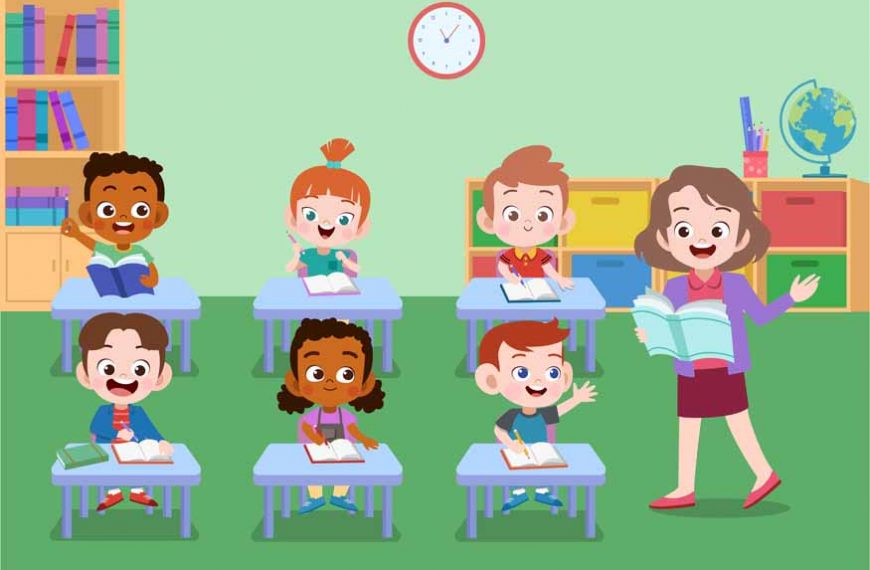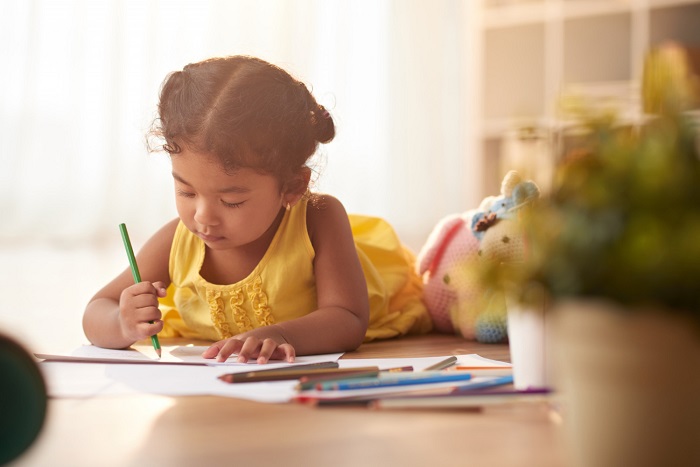8 Strategies for Calm Classrooms After Breaks
Maintaining order and controlling noise levels in a classroom can be difficult, especially after lunch or playtime. The shift from play to learning is a critical stage that has to be handled with care. In this article, we’ll look at eight strategies that can help your classroom stay calm and attentive following the boisterous breaks. We’ll look at kid-friendly stress-relieving techniques and activities, talk about maintaining discipline, and handle noise management, with a focus on discipline methods for preschoolers.
Calming Activities for Kids:
Children are frequently excited and energized after lunch or playtime, so it’s important to provide them with activities that will help them calm down and ease into a focused learning atmosphere. Children can unwind and focus their attention by including exercises in deep breathing, brief mindfulness practises, or quiet reading time. These tasks not only provide a feeling of routine but also help people focus better and feel less restless.
How to Maintain Discipline in the Classroom:
For the purpose of providing a favorable learning environment, discipline must be upheld. The enthusiasm of the students after lunch or playtime might occasionally result in disturbances. It is essential to implement a precise set of rules and expectations for the classroom. Make sure children are aware of the repercussions of breaking the rules; consistency is vital. Students can be inspired to conduct themselves responsibly by receiving praise and awards, which constitute positive reinforcement. Setting an excellent personal example of discipline may also have a significant influence on how pupils view and use it.
Noise Control:
Noise management is essential for classroom management, especially after lunch or during playtime when kids may still be feeling upbeat. Effective strategies include employing a specific signal— like raising your hand— to indicate when it’s time to remain silent. Students who need a minute to collect themselves can escape to a “quiet corner” that has plush pillows and low lighting. Interactive dialogues that teach students to be mindful of their noise levels may help instill a feeling of responsibility for upholding a calm learning environment.
Discipline Techniques for Preschoolers:
Discipline for preschoolers must be tailored to their specific requirements. A patient approach is necessary when returning children to a controlled setting after lunch or playtime. Use strategies like positive redirection, in which you move a child’s focus to a more suitable activity. Include captivating graphics to assist people in comprehending impulse control, such as a “calm down” poster with illustrative instructions. Preschoolers can feel secure and predictable when a consistent routine is used with visual signals, which helps with behavior control.
Interactive Storytelling:
Engage your pupils with a brief interactive tale about self-control and behavior management. To assist kids in understanding the value of being quiet after lunch or playtime, use realistic stories and personalities. After the narrative, start a group conversation regarding the characters’ decisions and emotions. This method not only teaches children important lessons but also fosters empathy and self-awareness in them.
Transition Activities:
Transitions that go smoothly are essential for keeping a well-run classroom. Include transitional activities that will aid pupils in shifting their attention from play to learning. These exercises might consist of a brief talk about what they’re excited to study in future classes or a fast recap of what they studied before the break. By getting kids involved in these activities, you give them a feeling of direction and anticipation while reducing disturbances brought on by pent-up energy.
Visual Timers:
In the classroom, visual clocks are useful tools for controlling time and expectations. Please set up a timer that informs students of their remaining opportunities to unwind and prepare for the following class. Thanks to this visual aid, students will find it simpler to comprehend and follow the transition process, which gives time a concrete depiction. They’ll gradually come to identify the visual timer with the requirement to be silent, eliminating the need for frequent verbal reminders.
Music and Sound:
Include calming music or soft noises in your post-lunch or post-recess routine. Reduce the level gradually to mark the change from break to learning time. Students can internalize the concept of quieting down with the aid of this aural signal. They’ll come to equate relaxing music with the need to concentrate and pay attention over time. Consistency in music choice will create a sensory anchor that will help with transitions.
8 Ways To Calm Your Class:
After lunch, there are eight techniques to relax your class so that your kids feel more at ease and are better able to focus in their afternoon classes.
- Yoga Practice with Your Students: According to “Harvard Health Publishing,” yoga is a great method to get kids moving while simultaneously promoting concentration and relaxation. Yoga provides several benefits for kids, including improved body awareness, enhanced flexibility and strength, and peace and relaxation. An excellent method to establish a connection with your pupils is via yoga. If you’re searching for a relaxing and enjoyable exercise to perform with your pupils, consider introducing yoga lessons into your lesson plan. Start by showing them simple positions like Warrior III and Downward Dog.
- Play a Few Brain Games: One of the fun and successful soothing exercises for kids is playing a brain game. Brain games may keep a child’s mind active and promote feelings of well-being and achievement. Brain games can assist in lowering tension and enhancing attention by offering a diversion from whatever is irritating the player. Finding a brain game suitable for your child’s interests and age is straightforward due to the wide variety of brain games accessible. Popular alternatives include Sudoku, memory games, and crossword puzzles. The best part is that brain games are constantly available and may be played both online and offline.
- Colouration: One of the best hobbies for youngsters to calm down is coloring. Coloring demands focus and concentration, which can help kids unwind and get ready for school. As it is a calm activity, it can also aid children in relaxing after a boisterous lunch hour. Children can use their imagination in this way. As well as giving students an enjoyable respite from typical academics, this may get them ready for impending exams or assignments. There are many coloring books available featuring popular characters from TV series, movies, and novels. Additionally, coloring sheets on the internet may be printed. Have a tonne of markers or crayons on hand, regardless of what you choose.
- Instruct on Calming Breathing Exercises: Children are frequently antsy and stimulated after lunch or playtime. To aid in relaxation, teach them some relaxing breathing techniques. To start, have them inhale several long, deep breaths and exhale. After that, instruct them to shut their eyes and focus just on breathing. Permit them to inhale and count to four, then exhale to four. Once they get the hang of it, boost the count to eight. Their bodies and minds will relax if they take long, deep breaths. If they start to fidget, ask them to focus on breathing and count again.
- While doing an activity, listen to or watch relaxing music or videos: Whatever you decide to do with your kids to help them unwind after lunch, we suggest playing some calming music or running a peaceful film in the backdrop to create a tranquil atmosphere. Live Streams of animals or other natural phenomena, like this one of a tropical reef, are wonderful and calming to watch. Watching fish move about and listening to relaxing music while drawing or practicing breathing exercises might help children relax. Any quiet after-lunch activity can benefit significantly from the inclusion of a little calming music for kids. Music lowers tension and anxiety by causing our brains to release feel-good hormones. Children can focus on their work more effectively and productively by listening to calming music.
- Play Knowledgeable and Informative Videos: Now is the moment to present any videos you intend to utilize in your lesson plan. It’s a fantastic approach to engage pupils and get them studying. You may also just play them amazing videos that are good for their overall growth, like ones that highlight an original artist or teach them how to live a healthy life. Online, several relaxing films use guided relaxation and imagery techniques.
- Create a Calm Environment: Play calming tunes. Excellent options are gentle acoustics, calm jazz, or classical music. Let the calming tones of the violin or the piano lull your kids to sleep. You might listen to relaxing noises like a storm or ocean waves instead of music. There are a lot of video and audio websites with huge libraries of calming music and noises. You can also discover soothing videos to watch. Your kids might need something to zero in on because they are more visually inclined. Videos from aquariums and the outdoors are wonderful options for this. Additionally, there are films of ocean waves, space vistas, and even a roaring fire for chilly winter days.
- Positive Affirmations: Affirmations are quite powerful. Simply concentrating on positive affirmations for a short period of time as a class may inspire and motivate students in preparation for the afternoon’s courses. Affirmations that are positive influence or create subconscious thoughts. At this profound level, we may develop healthy self-beliefs that will help us over the long term, such as boosting self-confidence and self-esteem.
After lunch or playtime, teachers must use a variety of ways to keep order and control noise levels in the classroom. These techniques must involve and empower the kids. Educators may foster a learning atmosphere by including soothing activities, setting clear expectations, and concentrating on disciplining methods suitable for various age groups. By using these strategies, you can guarantee a seamless transition while simultaneously teaching necessary self-control and behavior management skills that go beyond the classroom. As instructors, it is our duty to help students direct their energy in constructive directions, promoting an enjoyable and laser-focused learning environment.














